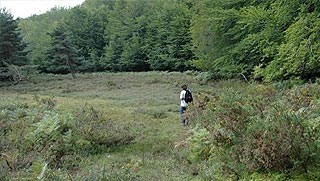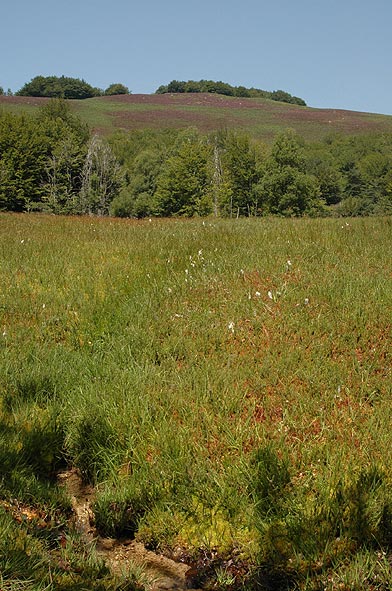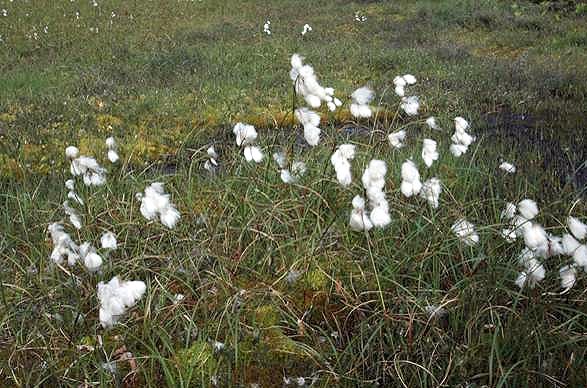Name of the site: Baltsagorrieta
Protection categories: Listed as Protected Non-developable Land due to its Environmental Value, Wetlands, in Navarre’s Land Planning Programme 3 “Central Area”.
Location: Belongs to the Valley of Esteribar and is located alongside the boundary with Anue.
Region: Navarre
Coordinate reference: XN 1759, XN1760
Surface area of the wetland: 2.69 hectares
See PDF map
This site, located in a clearing in a beech wood, is a flat area on a hillside near the head of a gully. It consists of two areas at different levels: The upper level is flat and fairly dry; the larger, lower area has a certain slope and is very waterlogged.
The two levels are joined by a slope covered with beech and pine trees, ferns and gorse. The following may serve as a general summary
In the higher area, where peat has not developed or the deposit is shallow, we can distinguish between two areas with flowing water,
- the North, with dispersed flowing spring water, with great fluctuations in terms of flow and mesotrophic waters,
- the South, highly heterogeneous, with unstable flows which function on an irregular basis, as reflected by the presence even of dead young beech trees on the western boundary, and more acid waters.
The lower, wet area is much larger, uniformly waterlogged and has a good deposit of peat (approximately 1.5 m deep).
At the upper edge, there is a spring point from which minerotrophic waters flow and whose influence permits the growth of Menyanthes trifoliata, there also existing other outflow points which would appear to be fairly unstable in terms of situation and operation.
This area has a channel on each side, the one in the west being shorter, shallower and narrower than the one on the eastern edge, which runs beneath a line of Salix atrocinerea.
Drainage takes place via a single stream leaving the area, where the peat deposit stops quite abruptly and emissions of methane and hydrogen sulphide can be detected.
- MOST IMPORTANT VALUES
Uniqueness
The site can be considered one of the four peatlands, in the strict sense of the word, detected in Navarre, and one of the only two which are unmistakeably active. The origin of the site is an extremely particular structure: a thrust fault forcing a significant pack of sandstone (permeable) on top of loamy rocks (impermeable), and its conservation is due to the constant, abundant flow from the aquifer hanging in the structure.Biological and ecological values
The vegetation in the peat-deposit area is noteworthy: Eriophoro angustifolii-Sphagnetum rubelli. The presence of Pinus sylvestris and Betula pubescens subsp. celtiberica, which could draw the site near to the status of bog woodland (91D0*), although of an extraordinarily poor nature due to both climate and orientation, is also worthy of mention.
As far as plant species are concerned, the presence of Menyanthes trifoliata, Sphagnum rubellum and S. fallax (neither sphagnum had been cited in Navarre) deserves special attention.Historical and paleoecological values
The site has a considerable peat deposit (1.5 metres), yet to be studied.Habitats of Community Interest
Hábitat Nombre 4010 Brezales húmedos atlánticos septentrionales de Erica tetralix 4030 Brezales secos europeos 6410 Prados con molinias sobre sustratos calcáreos, turbosos o arcillo-limónicos (Molinion caeruleae) 7140 «Mires» de transición 91D0* Turberas boscosas Flora
66 species of vascular plant and 39 bryophyte species, seven of which are sphagnums, have been recorded.
Of the vascular plants, the most noteworthy feature is the presence of the hybrid Salix aurita x atrocinerea. The abundance of Lastrea limbosperma and the presence of Polygonatum verticillatum, Gentiana lutea and Convallaria majalis among the birch and beech trees is also relevant. In the waterlogged areas, the presence of Eriophorum angustifolium and Trichophorum caespitosum subsp. germanicum is noteworthy, as is that of Nardus stricta and Juncus squarrosus in the surrounding grasslands.
As for bryophytes, a few novelties for the catalogue of Navarre are worthy of mention: the hepatics Calypogeia integristipula, Cephalozia connivens, Cladopodiella fluitans, Kurzia pauciflora and Scapania mucronata, and the mosses Sphagnum magellanicum, Sphagnum rubellum and Splachnum ampullaceum, a dung moss. The presence of Sphagnum magellanicum, a particularly peat-forming and ombrophilous sphagnum, is particularly relevant.Fauna
The site is home to the viviparous lizard (Zootoca vivipara), listed as “Near Threatened” by the IUCN and included in Spain’s List of Specially Protected Species.- PHOTOS





